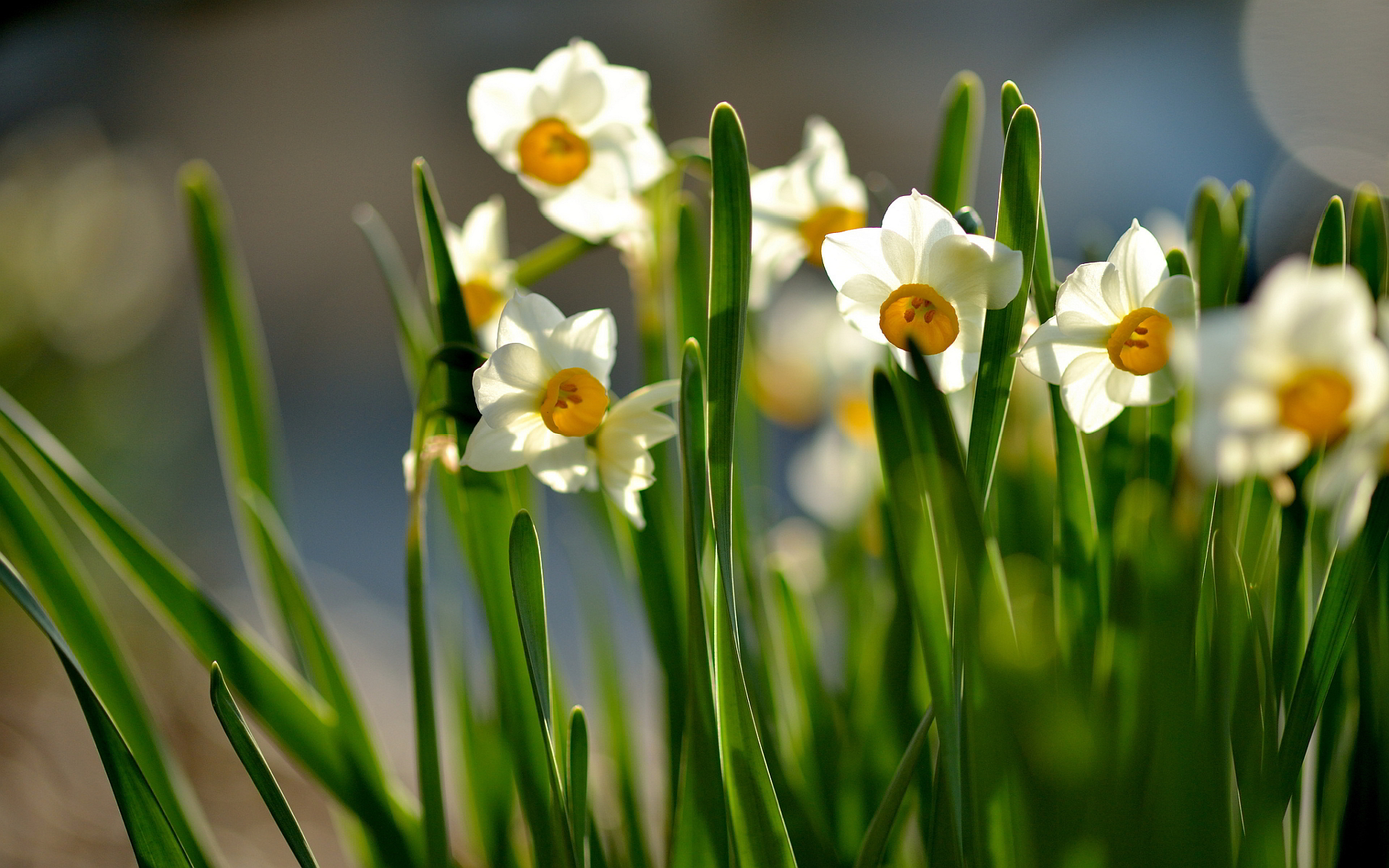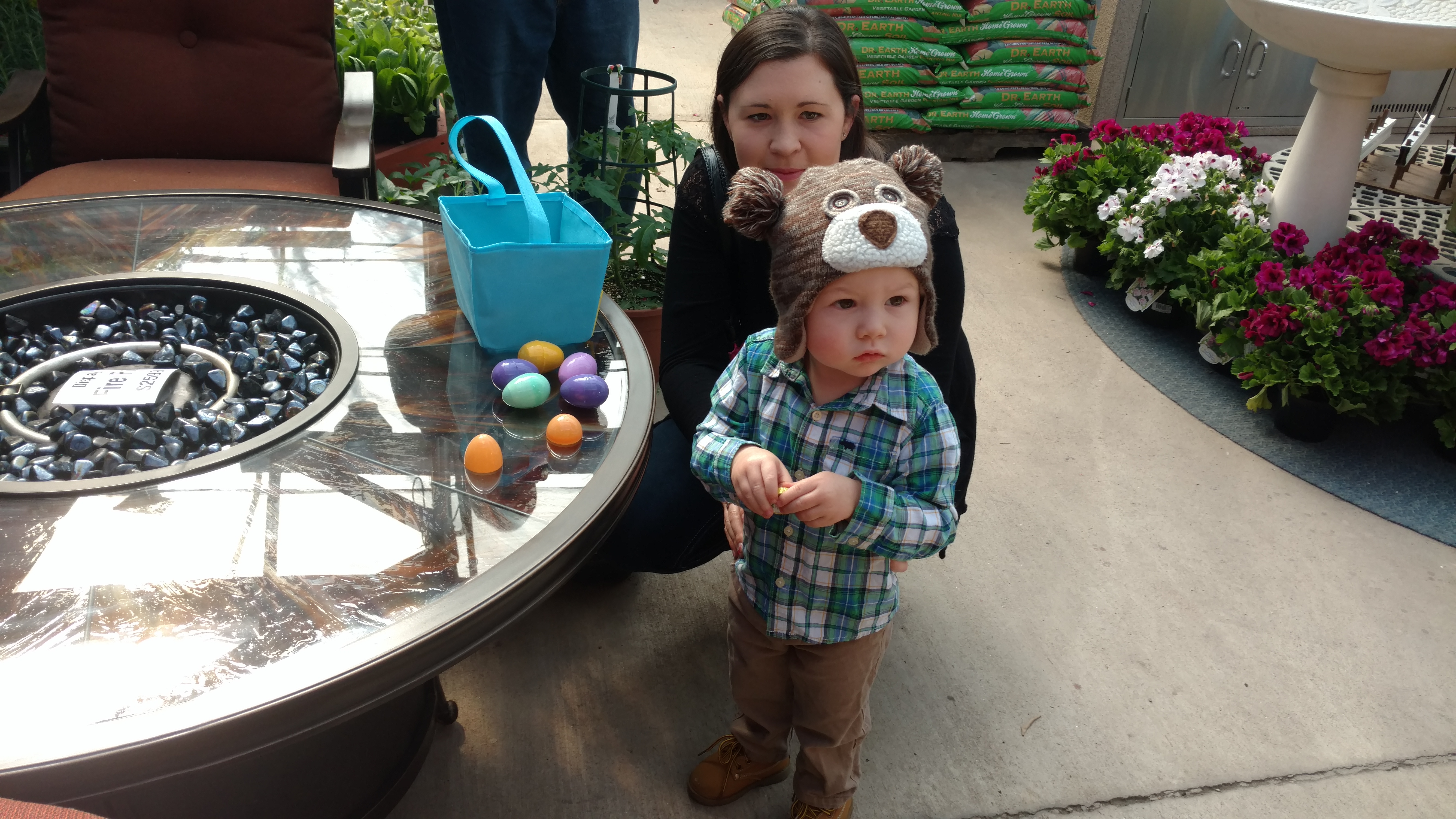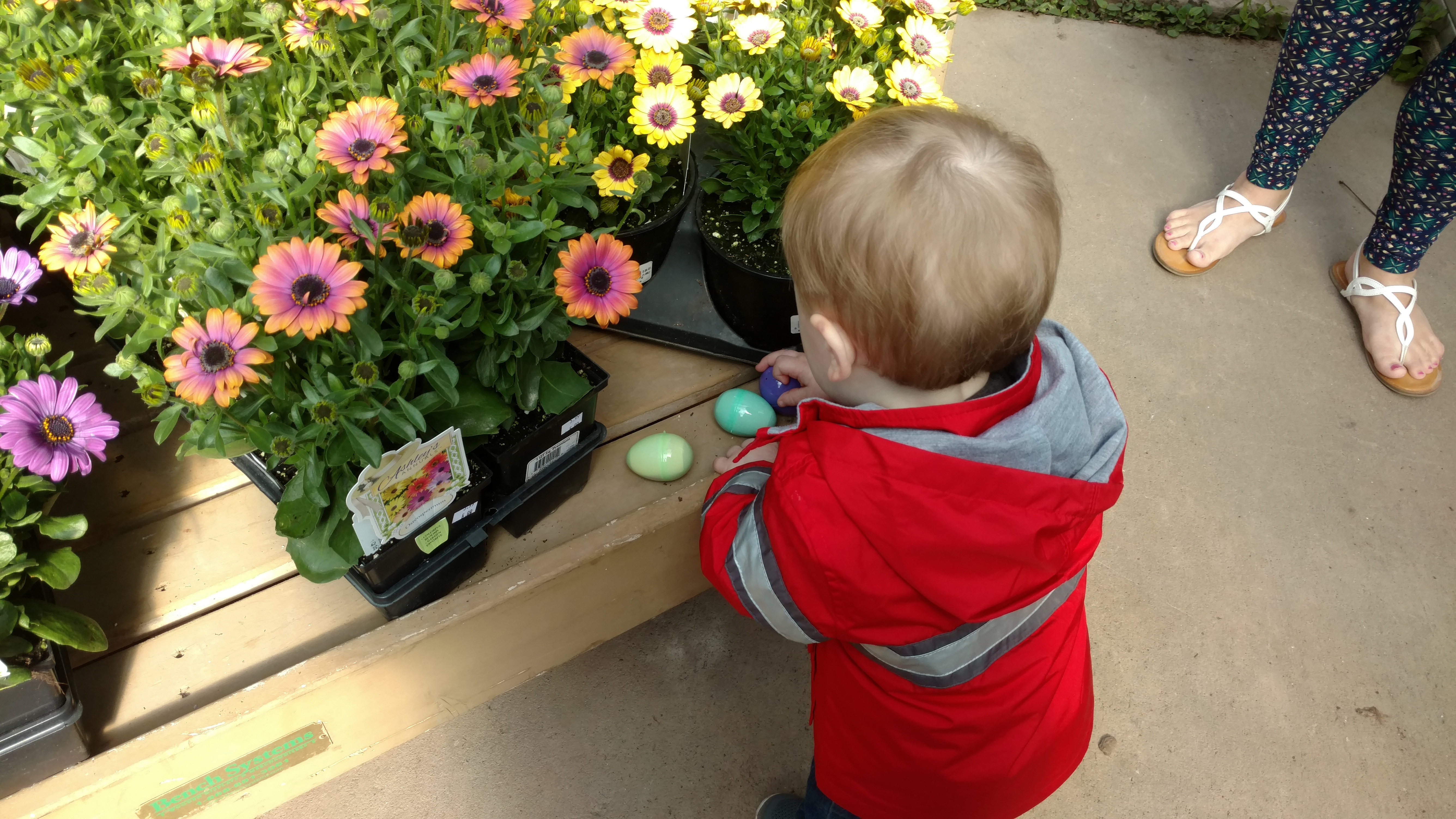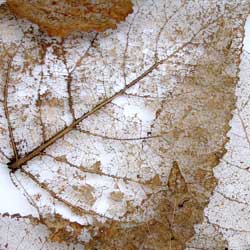Our Easter Egg Hunt and Easter Bunny visit was a great success!!
What a great time we had this past weekend at our Easter Egg hunt and Easter Bunny Visit! Stop on by this week for some great savings as well as checking out our new spring plant arrivals!
Don’t forget our Mulch Madness sale is still going on!















Insect Control Begins Now
It’s hard to think of insects in winter, but don’t forget the havoc these tiny creatures can bring to your garden – defoliating leaves, contaminating produce, even destroying complete plants. Before these pests begin to be a problem is the perfect time to take steps to control them.
Why Winter Control?
Late winter is the right time to control insects for two reasons. First, the insects and their eggs are just coming out of dormancy. The shells and protective coverings are softer and more porous in late winter, and so are more vulnerable to the effects of oils and sprays. Second, the oil-water mixture should not freeze on the tree or plants, which could damage the plant and make the spray far less effective. When you spray, the temperature should be above 40 degrees. Delay spraying if freezing night temperatures are predicted. Choose a calm day for spraying to be sure stray breezes and cross winds do not spread the spray to plants you don’t want covered.
Insects to Control
In late winter, before any leaf buds begin to open, spray Bonide All-Season Oil or Dormant Oil Spray on fruit trees or other ornamental trees or shrubs to suffocate over-wintering aphids, thrips, mealybugs, whitefly, pear psylla, scale and spider mites that cling to the bark. The treatment will also destroy the eggs of codling moths, Oriental fruit moths and assorted leaf rollers and cankerworms. Don’t wait until the buds have burst in early spring, as the coating of oil will also smother the emerging plant tissue.
Tree Spraying Tips
While small shrubs can be easy to treat, larger trees are more challenging to be sure you don’t leave any area untreated where insects can thrive. Spray the whole tree at one time, concentrating on the trunk, large branches and crotches, rather than spraying down a whole row of trees at one pass. If you’ve experienced extremely bad infestations of insects, you might treat your trees a second time. But be sure to spray before the buds are near the bursting point. Dormant oil can also be used after the leaves have dropped in the fall. Never spray when any foliage or fruit is on the trees or you risk unwanted pesticide contamination.
After you spray, be sure to store any remaining oil properly and out of reach of children and pets. Containers should be labeled clearly and kept in cool, dark spaces to preserve their usefulness. Avoid reusing any sprayers to minimize the risk of cross contamination or inadvertent use.
Spraying for insects in winter may not be the most glamorous job, but you’ll appreciate the improvement in your trees through the spring and summer when you’ve nipped your insect problems in the bud.
It’s hard to think of insects in winter, but don’t forget the havoc these tiny creatures can bring to your garden – defoliating leaves, contaminating produce, even destroying complete plants. Before these pests begin to be a problem is the perfect time to take steps to control them.
Why Winter Control?
Late winter is the right time to control insects for two reasons. First, the insects and their eggs are just coming out of dormancy. The shells and protective coverings are softer and more porous in late winter, and so are more vulnerable to the effects of oils and sprays. Second, the oil-water mixture should not freeze on the tree or plants, which could damage the plant and make the spray far less effective. When you spray, the temperature should be above 40 degrees. Delay spraying if freezing night temperatures are predicted. Choose a calm day for spraying to be sure stray breezes and cross winds do not spread the spray to plants you don’t want covered.
Insects to Control
In late winter, before any leaf buds begin to open, spray Bonide All-Season Oil or Dormant Oil Spray on fruit trees or other ornamental trees or shrubs to suffocate over-wintering aphids, thrips, mealybugs, whitefly, pear psylla, scale and spider mites that cling to the bark. The treatment will also destroy the eggs of codling moths, Oriental fruit moths and assorted leaf rollers and cankerworms. Don’t wait until the buds have burst in early spring, as the coating of oil will also smother the emerging plant tissue.
Tree Spraying Tips
While small shrubs can be easy to treat, larger trees are more challenging to be sure you don’t leave any area untreated where insects can thrive. Spray the whole tree at one time, concentrating on the trunk, large branches and crotches, rather than spraying down a whole row of trees at one pass. If you’ve experienced extremely bad infestations of insects, you might treat your trees a second time. But be sure to spray before the buds are near the bursting point. Dormant oil can also be used after the leaves have dropped in the fall. Never spray when any foliage or fruit is on the trees or you risk unwanted pesticide contamination.
After you spray, be sure to store any remaining oil properly and out of reach of children and pets. Containers should be labeled clearly and kept in cool, dark spaces to preserve their usefulness. Avoid reusing any sprayers to minimize the risk of cross contamination or inadvertent use.
Spraying for insects in winter may not be the most glamorous job, but you’ll appreciate the improvement in your trees through the spring and summer when you’ve nipped your insect problems in the bud.that cling to the bark. The treatment will also destroy the eggs of codling moths, Oriental fruit moths and assorted leaf rollers and cankerworms. Don’t wait until the buds have burst in early spring, as the coating of oil will also smother the emerging plant tissue.
Tree Spraying Tips
While small shrubs can be easy to treat, larger trees are more challenging to be sure you don’t leave any area untreated where insects can thrive. Spray the whole tree at one time, concentrating on the trunk, large branches and crotches, rather than spraying down a whole row of trees at one pass. If you’ve experienced extremely bad infestations of insects, you might treat your trees a second time. But be sure to spray before the buds are near the bursting point. Dormant oil can also be used after the leaves have dropped in the fall. Never spray when any foliage or fruit is on the trees or you risk unwanted pesticide contamination.
After you spray, be sure to store any remaining oil properly and out of reach of children and pets. Containers should be labeled clearly and kept in cool, dark spaces to preserve their usefulness. Avoid reusing any sprayers to minimize the risk of cross contamination or inadvertent use.
Spraying for insects in winter may not be the most glamorous job, but you’ll appreciate the improvement in your trees through the spring and summer when you’ve nipped your insect problems in the bud.
Summer Rose Care Tips
 Summer Rose Care Tips
Summer Rose Care Tips
Aahh, mid summer. This is the time of the year when all the annuals you planted this spring are finally blooming. And the long, warm days seem to intensify the fragrance of summer blooming Lilies and roses. It’s the time to revel in the glory of the garden.
But, then you notice a few flaws. Uh, oh, that rose plant over there just doesn’t look like it’s doing very well. What’s the deal? Mid summer, in all it’s glory, can also create stressful conditions for plants. All that heat causes plants to move water through their systems (evapotranspiration) pretty quickly. If plants don’t have enough water, they get stressed out in the heat. They can’t just pick themselves up and move into the shade or go get a drink of water like we can.
As you look a bit closer you notice there are some funny looking bugs covering the new growth on your roses. Mid summer can bring out the aphids in full force. Especially, if you haven’t had any recent heavy rains to wash them off the plants.
Then you notice that a rose in the corner has some funny spots on its leaves, a few leaves are turning yellow, and some have fallen off the plant. Oh god, blackspot!
And, then you start thinking that perhaps your roses aren’t blooming as much as they should be. If your soil is a bit low on the fertility scale, the blooms may be in short supply. What to do, what to do!! First, don’t worry. These minor problems are just that — minor. And, they’re easily fixed.
Water
The most important thing your roses need this time of year is water. They demand the equivalent of at least one inch of rain each week. That’s about equal to one gallon of water per plant. So, if it hasn’t rained, give your roses some water.
The best way to water your roses is with a soaker hose that causes the water to slowly saturate the soil. These are usually made out of recycled tires and can be laid right on top of the soil and covered with mulch. This works great — no evaporation and the water slowly soaks into the soil. I actually run mine overnight. The mulch on top of the hose prevents any water from squirting onto the roses, so watering at night is great. Just remember to turn off the hose in the morning. Or, better yet, set it on a timer.
Water is the ultimate “fertilizer.” It moves nutrients from the soil into the plant. And a consistent supply prevents the rose from getting stressed by heat. A nonstressed, healthy rose can better defend itself from insects and disease.
Bugs
 Mid summer bug problems on roses are usually caused by aphids. They are almost always found on the new growth of rose plants. They seem to come out in full force in mid summer when there hasn’t been much rain. Aphids suck the juices out of your roses and can cause leaves to curl and be disfigured.
Mid summer bug problems on roses are usually caused by aphids. They are almost always found on the new growth of rose plants. They seem to come out in full force in mid summer when there hasn’t been much rain. Aphids suck the juices out of your roses and can cause leaves to curl and be disfigured.
The best defense against aphids is healthy plants that have received adequate amounts of water. The second best defense is a good supply of ladybugs in your garden. I release these aphid eaters every two weeks during early summer and mid summer. They really clean up the aphid problems. Sometimes I have to wait a few days after the release to see the effects, but they do a great job in reducing aphid problems.
If the rain hasn’t come and the ladybugs haven’t done their job, then you need to stop the aphids before they take over. Insectidal soaps work great — they don’t hurt bees, fish, kids or you. But they’ll kill most soft bodied insects. It works by suffocating them.
The trick to success with insectidal soap is to apply it twice. First, spray it on the aphids (it has to have contact with the bug to work) late in the day — usually right before sunset. Spraying late in the day prevents leaf damage caused by the sun hitting the spray or heat reacting with the spray. Then, two days later go out and spray any aphids that escaped your first spray. You’ll be amazed at how quickly they reproduce! If you miss one, you’ll quickly have hundreds in a matter of days. I think they’re born pregnant.
Another quick way to get rid of aphids is to squish them between your fingers. Or, if you can’t handle that, then wash them off the plant with water — a hose set on high pressure works well (be careful not to blast the leaves off your plants).
Disease
 Rose diseases are what keeps lots of people from growing roses. The idea of dragging out an arsenal of chemicals and spraying them over the entire garden once a week is enough to cause even the most undaunted gardener to wonder what the heck they’re doing.
Rose diseases are what keeps lots of people from growing roses. The idea of dragging out an arsenal of chemicals and spraying them over the entire garden once a week is enough to cause even the most undaunted gardener to wonder what the heck they’re doing.
What to do? First, decide what you’re willing to accept. Remember the words to a Joni Mitchell song, “please farmer farmer put away that DDT, leave the spots on the apples and give me the birds and the bees.” If chemical control is not for you, you can still grow roses. First, you have to select roses that are less susceptible to disease and then you have to keep them healthy by planting them in the right spot and giving them enough water and the right kind of food.
Right plant in the right place. Every garden is filled with “microclimates” that can be good for some plants and certain death for others. You know that corner spot in your garden that always has mosquitoes and slugs hanging out in the damp shade? Don’t plant a rose there. It will get disease, unless its made out of plastic. Plant your rose in sun with good air circulation and it will have what it needs to stay healthy without spraying. If it gets disease, consider replacing it with a variety that has more disease resistance.
Organic sprays. If you have a disease problem, there are organic products you can apply to your plants to prevent and control the diseases. Before World War II, there were very few agricultural chemicals used to control plant disease. And guess what, people were growing roses way before World War II.
To avoid disease problem, remember to: select roses that have good resistance to disease, plant them in the right spot, and feed and water them well.
Food
Roses are known as “heavy feeders” (or how about gluttons) when it comes to using up soil nutrients. But, they convert all those nutrients into a ton of blossoms, which is why we grow them, right?! So, if we expect them to bloom, we have to feed them.
We’ve got lots of pages devoted to fertilizing, which I’ve listed below. But, before you leave this page, there are a few pointers to keep in mind when fertilizing.
- Don’t apply liquid fertilizers to dry soils. The roses will suck up the fertilizer quickly and it may cause the leaves to burn.
- Avoid using liquid chemical fertilizers — especially on Rugosas! These types of fertilizers cause the most leaf burn and leaf drop. You don’t want to hurt your plants with fertilizers.
- Feed the soil, which in turn feeds the plants.





